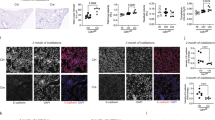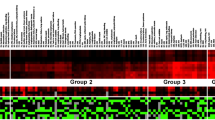Abstract
Paraffin sections were obtained of human fetal, adult, and pathological lung (pulmonary fibrosis after radiotherapy or chemotherapy). The localization of epithelial adhesion molecules E-cadherin and Ep-CAM (former epithelial surface 40 kDa glycoprotein) was investigated by immunoperoxidase and/or immunofluorescence techniques with monoclonal antibodies. During development, the epithelia of the primary pulmonary primordium, the secondary bronchi and the adult bronchial epithelium retained immunoreactivity for E-cadherin and Ep-CAM with lateral immunostaining of cell membranes. In normal adult lungs, Ep-CAM was detected in type I and II alveolar epithelial cells, whereas E-cadherin was confined to the basolateral domain of type II cells. In pulmonary fibrosis, Ep-CAM could be further detected on the cell surface of epithelial remnants. In contrast, E-cadherin expression was characterized by a change of the membrane localization to a spotty, cytoplasmic pattern in the alveolar epithelium, possibly indicating functional inactivation of the protein during fibrogenesis.
Similar content being viewed by others
References
Adamson IYR (1992) Relationship of mesenchymal changes to alveolar epithelial cell differentiation in fetal rat lung. Anat Embryol 185:275–280
Adamson IYR, Young L, King GM (1991) Reciprocal epithelial-fibroblast interactions in the control of fetal and adult rat lung cells in culture. Exp Lung Res 17:821–835
Behrens J, Birchmeier W, Goodman SL, Imhof BA (1985) Dissociation of Madin-Darby canine kidney epithelial cells by the monoclonal antibody anti-Arc-1: mechanistic aspects and identification of the antigen as a component related to uvomorulin. J Cell Biol 101:1307–1315
Behrens J, Mareel MM, Van Roy FM, Birchmeir, W (1989) Dissecting tumor cell invasion: epithelial cells acquire invasive properties after the loss of uvomorulin-mediated cell-cell adhesion. J Cell Biol 108:2435–2447
Birchmeier W, Weidner KM, Hülsken J, Behrens J (1993) Molecular mechanisms leading to cell junctions (cadherin) deficiency in invasive carcinomas. Semin Cancer Biol 4:231–239
Böhm M, Totzek B, Birchmeier W, Wieland I (1994) Differences of E-cadherin expression levels and patterns in primary and metastatic human lung cancer. Clin Exp Metastas 12:55–62
Boller K, Vestweber D, Kemler R (1985) Cell-adhesion molecule uvomorulin is localized in the intermediate junctions of adult intestinal epithelial cells. J Cell Biol 100:327–332
Crouch E (1990) Pathobiology of pulmonary fibrosis. Am J Physiol 259:L159-L184
Cunningham AC, Milne DS, Wilkes J, Dark JH, Tetley TD, Kirby JA (1994) Constitutive expression of MHC and adhesion molecules by alveolar epithelial cells (type II pneumocytes) isolated from human lung and comparison with immunocytochemical findings. J Cell Sci 107:443–449
Dobds LG, Williams MC, Brandt AE (1985) Changes in biochemical characteristics and pattern of lectin binding of alveolar type II cells with time in culture. Biochem Biophys Acta 846:155–166
Griffin M, Bhandari R, Hamilton G, Chan Y-C, Powell JT (1993) Alveolar type II cell-fibroblast interactions, synthesis and secretion of surfactant and type I collagen. J Cell Sci 105:423–432
Kasper M, Rudolf T, Hahn R, Peterson I, Müller M (1993) Immuno-and lectin histochemistry of epithelial subtypes and their changes in a radiation-induced lung fibrosis model of the mini pig. Histochemistry 100:367–377
Kasper M, Schuh D, Müller M (1994a) Immunohistochemical localization of the β subunit of prolyl 4-hydroxylase in human alveolar epithelial cells. Acta Histochem 96:309–313
Kasper M, Haroske G, Müller M (1994b) Species differences in lectin binding to pulmonary cells: soybean agglutinin (SBA) as a marker of type I alveolar epithelial cells and alveolar macrophages in mini pigs. Acta Histochem 96:63–73
Kawanami O, Ferrans VJ, Crystal RG (1982) Structure of alveolar epithelial cells in patients with fibrotic lung disorders. Lab Invest 46:39–53
Lee M-G, Sharrow SO, Farr AG, Singer A, Udey MC (1994) Expression of the homotypic adhesion molecule E-cadherin by immature murine thymocytes and thymic epithelial cells. J Immunol 152:5653–5659
Litvinov SV, Velders MP, Bakker HAM, Fleuren GJ, Warnaar SO (1994) A human epithelial antigen is a homophilic cell-cell adhesion molecule. J Cell Biol 125:437–446
Moll R, Mitze M, Frixen UH, Birchmeier W (1993) Differential loss of E-cadherin expression in infiltrating ductal and lobular breast carcinomas. Am J Pathol 143:1731–1742
Momburg F, Moldenhauer G, Hämmerling GJ, Möllner P (1987) Immunohistochemical study of the expression of a Mr 34000 human epithelium-specific surface glycoprotein in normal and malignant tissues. Cancer Res 47:2883–2891
Monteford S, Holgate ST (1991) Adhesion molecules and their role on inflammation. Respir Med 85:91–99
Pilewski JM, Albelda SM (1993) Adhesion molecules in the lung. An overview. Am J Rev Respir Dis 148:S31-S37
Pizarro A, Benito N, Navarro P, Palacios J, Cano A, Quantanilla M, Contreras F, Gamallo C (1994) E-cadherin expression in basal carcinoma. Br J Cancer 69:157–162
Rannels S, Rannels DE (1989) The type II pneumocyte as a model of lung cell interaction with the extracellular matrix. J Mol Cell Cardiol 21:151–159
Sannes PL (1991) Structural and functional relationships between type II pneumocytes and components of extracellular matrices. Exp Lung Res 17:639–669
Shimamura K, Takahashi T, Takeichi M (1992) E-cadherin expression in a particular subset of sensory neurons. Dev Biol 152:242–254
Shimoyama Y, Hirohashi S, Hirano S, Noguchi M, Shimosato Y, Takeichi M, Abe O (1989) Cadherin cell-adhesion molecules in human epithelial tissues and carcinomas. Cancer Res 49:2128–2133
Shiozaki H, Tahara H, Oka H, Miyata M, Kobayashi K, Tamura S, Iihara K, Doki Y, Hirano S, Takeichi M, Mori T (1991) Expression of immunoreactive E-cadherin adhesion molecules in human cancers. Am J Pathol 139:17–23
Takeichi M (1988) The cadherins: cell-cell adhesion molecules controlling animal morphogenesis. Development 102:639–655
Takeichi M (1991) Cadherin cell adhesion receptors as a morphogenetic regulator. Science 251:1451–1455
Takeichi M, Inuzuka H, Shimamura K, Fujimori T, Nagafuchi A (1990) Cadherin subclasses: differential expression and their role in neural morphogenesis. Cold Spring, Harbor Symp Quant Biol 55:319–325
Tang A, Amagai M, Granger GL, Stanley Jr, Udey MC (1993) Adhesion of epidermal Langerhans cells to keratinocytes mediated by E-cadherin. Nature 351:82–85
Vleminckx K, Vakaet L, Mareel M, Fiers W, Van Roy F (1991) Genetic manipulation of E-cadherin expression by epithelial tumour cells reveals an invasion suppressor role. Cell 66:107–119
Yamashima T, Tohma Y, Yamashita Y (1992) Expression of cell adhesion molecule E-cadherin in human arachnoid villi. J Neurosurg 77:749–756
Young SL, Adamson IYR (1993) Epithelial-fibroblast interactions in bleomycin-induced lung injury and repair. Environ Health Perspect 101:56–61
Young SL, Fram EK, Spain CL, Larson EW (1991) Development of type II pneumocytes in rat lung. Am J Physiol 260:L113-L122
Author information
Authors and Affiliations
Rights and permissions
About this article
Cite this article
Kasper, M., Behrens, J., Schuh, D. et al. Distribution of E-cadherin and Ep-CAM in the human lung during development and after injury. Histochem Cell Biol 103, 281–286 (1995). https://doi.org/10.1007/BF01457412
Accepted:
Issue Date:
DOI: https://doi.org/10.1007/BF01457412




